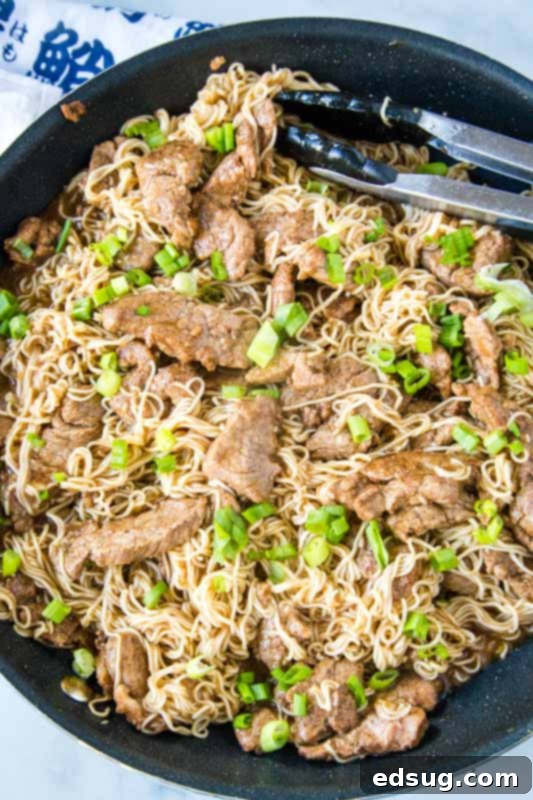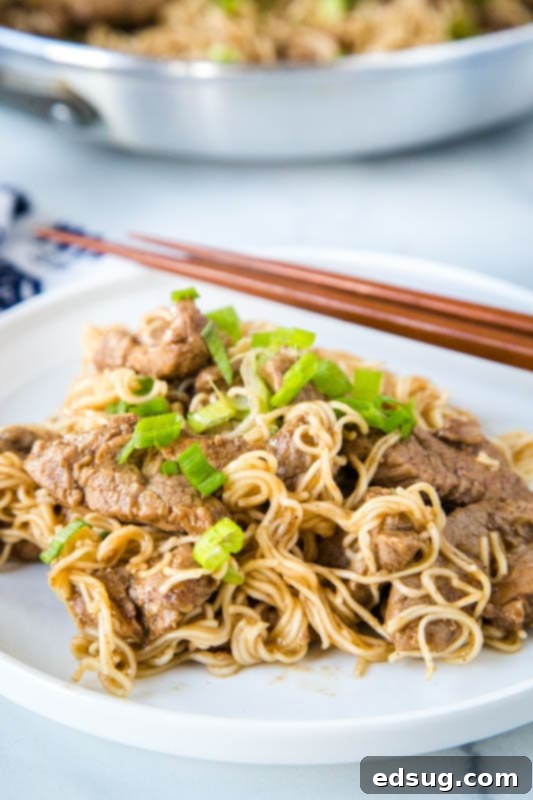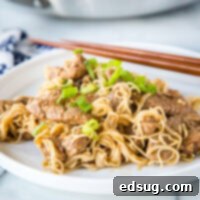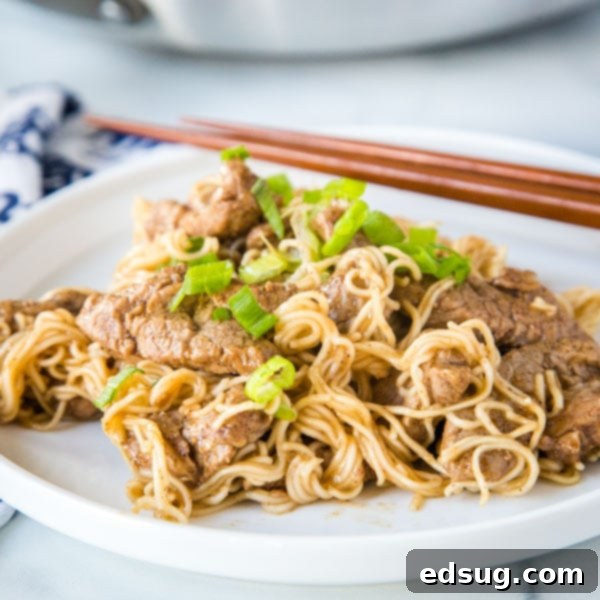Homemade Five Spice Pork Lo Mein: Your Ultimate Guide to a Flavorful & Easy Takeout Favorite
There’s a special comfort that comes with Chinese takeout – the promise of a quick, satisfying meal after a long day. Across the U.S., Chinese cuisine has become a beloved staple in countless households, and ours is certainly no exception. While we cherish our favorite local spots and go-to orders, there’s an undeniable magic in recreating these dishes at home. Over the years, I’ve transformed many takeout classics, like a beloved Cashew Chicken, into homemade versions. The ability to hand-pick fresh vegetables, control the quality of ingredients, and adjust flavors to your preference truly elevates the experience. This recipe for Five Spice Pork Lo Mein isn’t just a delicious meal; it’s an opportunity to bring the vibrant flavors of your favorite Chinese restaurant directly into your kitchen, with a unique and aromatic twist.
If you’re a regular here, you know our deep appreciation for pork. It’s a versatile protein we enjoy in nearly every form, always stocked in our freezer. From sizzling Grilled Pork Chops during summer barbecues to hearty winter stews, pork is a constant. So, it should come as no surprise that pork takes center stage in this incredible lo mein recipe. While a more traditional Chicken Lo Mein already graces our blog, this pork variation introduces an exciting new dimension with the aromatic addition of Chinese Five Spice Powder. The beauty of lo mein lies in its adaptability; feel free to substitute any protein you prefer, whether it’s chicken, beef, shrimp, or tofu, and load it up with your favorite crisp vegetables.

Unlocking the Flavor: What Is Chinese Five Spice?
Chinese Five Spice Powder is a quintessential spice blend, deeply rooted in Chinese culinary traditions. It typically combines five fundamental flavors: sweet, sour, salty, bitter, and umami, though the blend itself manifests as an aromatic and complex profile. The standard components usually include:
- Star Anise: Providing a distinct licorice-like sweetness and aroma, star anise is often the most prominent flavor.
- Sichuan Peppercorn: Unlike black pepper, Sichuan peppercorn offers a unique citrusy, floral note with a tingly, numbing sensation that is characteristic of many regional Chinese dishes.
- Cinnamon (or Cassia): Adding warmth and a sweet, woody fragrance.
- Cloves: Contributing a pungent, sweet, and strong aromatic depth.
- Fennel Seeds: Offering a milder licorice flavor and a hint of sweetness.
This powerful combination isn’t spicy in the chili sense, but rather offers a profound depth of flavor that complements meats, poultry, and fish beautifully. It’s a common ingredient in marinades, rubs, and braising liquids, where it infuses dishes with its signature complexity. For our Five Spice Pork Lo Mein, it transforms a classic dish into something extraordinary, adding layers of savory, sweet, and aromatic notes that will tantalize your taste buds. You can often find pre-made Chinese five-spice powder in the spice aisle of most grocery stores or Asian markets, making this elevated flavor accessible to every home cook.

Lo Mein vs. Chow Mein: Understanding the Noodle Nuance
Often confused, Lo Mein and Chow Mein are two distinct Chinese noodle dishes, with their primary difference lying in how the noodles are prepared. Both typically utilize wheat-flour egg noodles, but their cooking methods yield vastly different textures:
- Lo Mein (捞面): The term “Lo Mein” literally translates to “tossed noodles.” In this preparation, the noodles are boiled until soft and tender, then drained and tossed with the sauce, meat, and vegetables. The noodles are meant to be the star, acting as a vehicle for the flavorful sauce, remaining soft and pliable.
- Chow Mein (炒面): Meaning “fried noodles,” Chow Mein typically involves frying the noodles until they are crisp or semi-crisp. There are two main styles: “crispy chow mein,” where the noodles are pressed and fried into a patty before toppings are added, and “steamed chow mein,” where they are stir-fried until slightly crispy. The noodles in chow mein often have a drier, chewier texture compared to lo mein.
While this distinction is traditionally upheld in authentic Chinese cuisine, American Chinese restaurants sometimes blur these lines, with “chow mein” occasionally referring to softer noodles. However, for this Five Spice Pork Lo Mein, we embrace the classic “tossed noodle” approach, ensuring a delightful, saucy, and tender noodle experience.
How to Craft the Perfect Five Spice Pork Lo Mein
Creating this flavorful pork lo mein at home is surprisingly simple and comes together in just about 20 minutes once your ingredients are prepped. Here’s a detailed breakdown of the steps to ensure a delicious outcome:
- **Prepare Your Noodles:** Start by cooking your chosen noodles according to the package directions. It’s crucial not to overcook them, as they will continue to absorb sauce later. Once cooked, drain them thoroughly. For easier eating and a better mix with the other ingredients, use kitchen scissors to snip the long strands into more manageable pieces (two or three snips usually suffice). When it comes to noodle choice, while specific “lo mein noodles” are ideal and often found in the Asian section of your grocery store, common alternatives like spaghetti, ramen (without the seasoning packet), or even thin udon noodles can work wonderfully in a pinch.
- **Season the Pork:** For this recipe, I highly recommend using pork tenderloin. Its lean nature and quick cooking time ensure it remains incredibly tender and juicy. Trim any silverskin from the tenderloin and slice it into thin strips, about 1/4 inch thick. In a medium bowl, combine the pork strips with the aromatic Chinese five-spice powder, fresh grated ginger, and half of the salt. Toss everything together until the pork is evenly coated. This seasoning step is key to infusing the pork with the distinctive five-spice flavor.
- **Sear the Pork:** Heat the canola oil in a large nonstick skillet or wok over medium-high heat until shimmering. A hot pan is essential for achieving a good sear on the pork. Add the seasoned pork strips to the hot pan, spreading them out as much as possible in a single layer to brown efficiently. Avoid overcrowding the pan, as this can steam the meat instead of searing it. Cook for about 2-3 minutes, stirring occasionally, until the pork is nicely browned and nearly cooked through.
- **Build the Sauce & Finish the Pork:** Once the pork is browned, stir in the remaining salt, water, and hoisin sauce. Hoisin sauce, a thick, sweet, and savory Chinese barbecue sauce, forms the backbone of our lo mein sauce, providing rich flavor and a beautiful glaze. Allow the mixture to simmer for another 1-2 minutes, stirring occasionally, until the sauce thickens slightly and the pork is fully cooked.
- **Combine and Serve:** Add the cooked and snipped noodles directly into the skillet with the pork and sauce mixture. Using tongs, toss everything together vigorously until the noodles are thoroughly coated with the flavorful sauce and pork. This ensures every bite is infused with the delicious five-spice and hoisin flavors. Garnish generously with freshly sliced green onions before serving immediately. The fresh crunch and mild onion flavor of the green onions add a perfect finishing touch.

Customizing Your Lo Mein: Add Your Favorite Veggies
This recipe offers a fantastic basic framework for pork lo mein, but don’t hesitate to make it your own by adding a medley of your favorite vegetables. Incorporating more veggies not only boosts nutrition but also adds color and texture. Excellent choices include:
- **Broccoli florets:** For a tender-crisp texture and vibrant green color.
- **Bell peppers:** Sliced red, yellow, or orange bell peppers add sweetness and crunch.
- **Mushrooms:** Sliced shiitake or cremini mushrooms absorb the sauce beautifully.
- **Carrots:** Julienned carrots add a subtle sweetness and bright orange hue.
- **Snow peas or snap peas:** For a crisp bite and fresh flavor.
- **Bok choy:** Roughly chopped bok choy wilts perfectly into the noodles.
To incorporate vegetables, you can either stir-fry harder vegetables (like broccoli or carrots) for a few minutes before adding the pork, or blanch them briefly in the noodle cooking water for a tender-crisp finish. Softer vegetables like mushrooms or bell peppers can be added with the pork or even towards the end of the cooking process to retain their bite.
This Five Spice Pork Lo Mein has been a beloved staple in our household for over a decade. It’s consistently devoured every time I prepare it, and the fact that it yields fantastic leftovers for lunch the next day is just an added bonus!
So, the next time you find yourself contemplating Chinese takeout, remember this recipe. Making delicious Chinese food at home is often much faster and simpler than you might imagine. In about 20-25 minutes, you can have a fresh, flavorful, and incredibly satisfying meal on your table, far surpassing any restaurant down the street.

More Irresistible Asian Recipes To Explore
If you loved this Five Spice Pork Lo Mein, you’ll surely enjoy exploring other delicious Asian-inspired dishes. Here are some more of our favorites:
- Kung Pao Chicken: A spicy, sweet, and savory stir-fry with tender chicken, peanuts, and vegetables.
- Egg Drop Soup: A light, comforting classic Chinese soup, perfect as an appetizer.
- General Tso’s Chicken: Crispy fried chicken pieces tossed in a sweet, savory, and slightly spicy sauce.
- Wonton Soup: Delicate wontons in a clear, flavorful broth.
- Chicken Lettuce Wraps: A fresh, light, and customizable appetizer or meal.
- Spicy Asian Noodles: Flavorful noodles with a kick, paired with tender chicken.
- Garlic Beef Noodle Bowls: Hearty and savory noodle bowls featuring tender garlic beef.

Five Spice Pork Lo Mein
Pin Recipe
Rate Recipe
Print Recipe
Ingredients
- 1 package uncooked Chinese-style noodles
- 1 tablespoon grated peeled fresh ginger
- 1 1/2 Tablespoons five-spice powder
- 1 approx 1 lbpork tenderloin, trimmed and cut into thin strips
- 1/2 teaspoon salt, , divided
- 2 tablespoons canola oil
- 1/2 cup water
- 1/2 cup hoisin sauce
- 1/2 cup chopped green onions
Instructions
-
Cook noodles according to package directions, omitting salt and fat; drain. Place in a large bowl. Snip noodles several times with kitchen scissors.
-
Combine ginger, five-spice powder, and pork in a medium bowl; add 1/4 teaspoon salt, tossing to coat. Heat oil in a large nonstick skillet over medium-high heat.
-
Add pork mixture; saute 2 minutes or until browned. Stir in remaining 1/4 teaspoon salt, water, and hoisin sauce; cook 2 minutes or until pork is done. Add pork mixture and green onions to noodles; toss well to combine.
Notes
Nutrition
Nutrition information is automatically calculated, so should only be used as an approximation.
Additional Info
Like this recipe? Leave a comment below!
I created a fun group on Facebook, and I would love for you to join us! It’s a vibrant community where you can share YOUR favorite recipes, ask questions, and stay updated on all the new culinary adventures at Dinners, Dishes and Desserts (so you never miss a new recipe)! If you’d like to be part of our growing food-loving family, you can request to join HERE.
Be sure to follow me on Instagram and tag #dinnersdishes so I can see all the wonderful DINNERS, DISHES, AND DESSERTS recipes YOU create!
Connect with Dinners, Dishes, and Desserts!
Stay connected and never miss out on new recipes, cooking tips, and culinary inspiration!
Facebook | Twitter | Pinterest | Instagram
